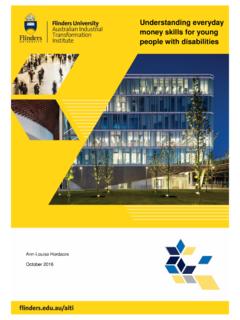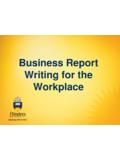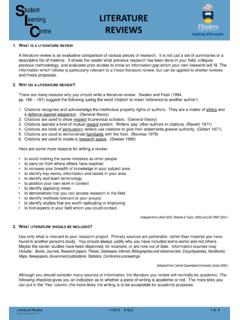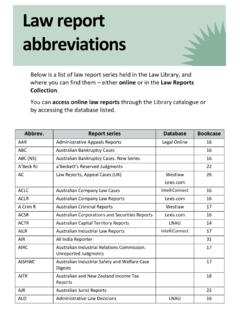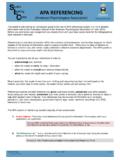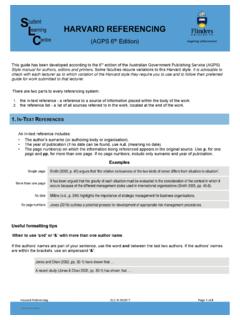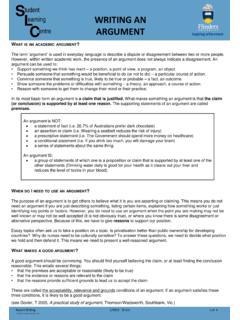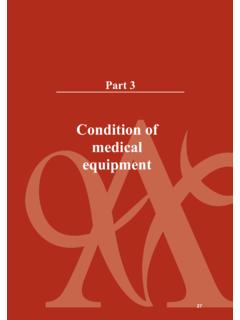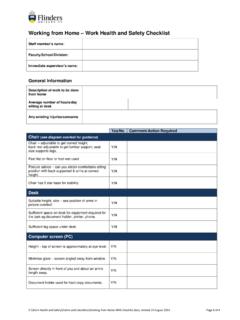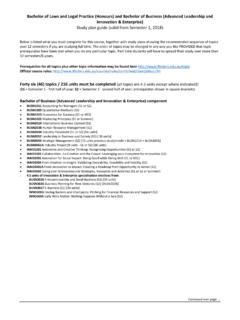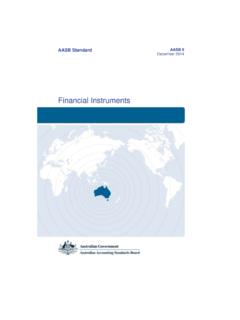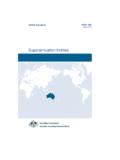Transcription of DISCLOSURE OF THE IMPACTS OF ADOPTING …
1 THE IMPACT OF ADOPTING AIFRS IN AUSTRALIA: THE EXTENT AND QUALITY OF DISCLOSURES, AND THEIR RELATIONSHIP TO CORPORATE CHARACTERISTICS Philip D. Palmerab School of Commerce, Flinders University, Adelaide, Australia Key Words: Voluntary DISCLOSURE , Mandatory DISCLOSURE , Agency Theory, international Accounting standards SCHOOL OF COMMERCE RESEARCH PAPER SERIES: 06-5 ISSN: 1441-3906 aPhilip D. Palmer, School of Commerce, Flinders University, GPO Box 2100, Adelaide, South Australia, 5001, phone 08 8201 2013, fax 08 8201 2644, b The author would like to thank Peter Gerhardy, Matthew Tilling, Carol Tilt and Bryan Howieson for their helpful input and comments on this paper. 1 THE IMPACT OF ADOPTING AIFRS IN AUSTRALIA: THE EXTENT AND QUALITY OF DISCLOSURES, AND THEIR RELATIONSHIP TO CORPORATE CHARACTERISTICS ABSTRACT This paper investigates the extent and quality of disclosures by companies complying with aasb 1047, Disclosing the IMPACTS of ADOPTING Australian Equivalents to international financial reporting standards , and whether they are related to selected corporate characteristics.
2 The key relationships examined are between extent of DISCLOSURE and company size, profitability, leverage, industry membership and auditor size. In addition exploratory hypotheses, suggesting a relationship between quality of DISCLOSURE and company size, profitability, leverage and auditor size are investigated. The study finds variation in the extent of DISCLOSURE by companies complying with aasb 1047. Results of the univariate tests and multiple regression analysis provide support for a positive relationship between the extent of DISCLOSURE and company size, profitability, leverage and auditor size, with the latter variable being the most significant. The tests do not support a relationship between differing levels of DISCLOSURE and industry membership.
3 The univariate and multivariate tests provide limited (and qualified) support for a relationship between the quality of DISCLOSURE and the size of a company s auditor. Univariate tests also provide limited support for a relationship between the quality of DISCLOSURE and the size and profitability of a company; however, there is no evidence of a relationship with the leverage of a company. 2 1. Introduction On 3 July 2002 the then chairman of the financial reporting Council (FRC), Jeffrey Lucy, announced that Australia would adopt international accounting standards from 1 January 2005 (FRC, 2002). Specifically, the FRC announced that from 1 January 2005 the accounting standards applicable to reporting entities under the [Corporations] Act will be the standards issued by the international Accounting standards Board (FRC, 2002).
4 The Australian Accounting standards Board ( aasb ), however, is responsible for making accounting standards that have the force of law under the Corporations Act, and it is only with these standards that Australian companies must comply. Therefore, the aasb decided to issue Australian equivalents, based on international financial reporting standards (IFRS). This decision of the FRC has led to significant changes to the accounting standards with which Australian companies must comply. The transition to Australian Equivalents of international financial reporting standards (AIFRS) is one of the most significant events affecting financial reporting in Australia for some time and is an important issue for companies, auditors and investors (ASIC, 2006).
5 As a means of keeping stakeholders informed of the likely impact of adoption of AIFRS the aasb released aasb 1047, Disclosing the IMPACTS of ADOPTING Australian Equivalents to international financial reporting standards , requiring companies to disclose in their financial reports details of how the transition to AIFRS is being managed and what the likely impact of adoption will be. The standard applies to annual and interim reporting periods ending on or after 30 June 2004, and applies until first time adoption of AIFRS. aasb 1047 is therefore of major significance as it requires companies to disclose in their annual reports their level of preparedness leading up to the adoption of AIFRS, and what they consider the IMPACTS of adoption 3 to be.
6 The objective of the disclosures required under aasb 1047 is to ensure users of financial reports have relevant and reliable information about the impact of adoption, as well as information concerning how companies are preparing for adoption. Jubb (2005) and Ernst & Young (2005) survey corporate disclosures in relation to aasb 1047 in order to highlight the major IMPACTS on their financial statements expected by companies as a result of adoption of AIFRS. Jubb s (2005) study examines Australian Stock Exchange (ASX) Section 4E Preliminary Final Reports and annual reports filed with them, as well as ASX Section 4D Half-year Reports. Disclosures required by aasb 1047 are examined, and the number of words devoted to these disclosures counted.
7 Disclosures relating to key differences in accounting policies expected to ensue as a result of ADOPTING AIFRS for each company are coded into categories ( Income Tax, Impairment, Share- based Payments, etc) and descriptive statistics compiled. Jubb (2005) finds that the most frequently cited expected accounting policy differences, in order of frequency, reported by the 808 companies making up the study sample are: 1. aasb 112 Income Taxes 2. aasb 136 Impairment of Assets 3. aasb 2 Share- based Payment 4. aasb 132 & 139 financial Instruments: Presentation and DISCLOSURE & financial Instruments: Recognition and Measurement 5. aasb 3 Business Combinations A similar analysis is conducted in the current study; however, the current study focuses on the annual report rather than ASX filings, as the annual report represents the major DISCLOSURE document to the external stakeholders of the reporting entity, and is where aasb 1047, para.
8 , prescribes that the impact of ADOPTING AIFRS be 4 disclosed. Further, as outlined in Section 3, the current study uses sentences as the unit of analysis, rather than words as used in Jubb s (2005) study. Ernst & Young (2005) examine disclosures made by the top 78 Australian listed companies with a focus on the impact on profit and on equity at the AIFRS transition date and at the end of the first AIFRS comparative year. Of the financial reports included in Ernst & Young s (2005) study, 21 were interim reports and 57 were annual reports. Similar to the current and Jubb s (2005) study, companies are classified according to Global Industry Classification Standard (GICS)1 sector; however, the number of companies in each category is not fully detailed.
9 In discussion of analysis of profit impact it is stated that there is only one company in the Utilities and Health Care sectors meaning the results in these sectors are not necessarily representative of the industry sector as a whole. Disclosures are categorised by aasb standard and used as the basis to determine the impact (high, medium, low) of each type of AIFRS adjustment, with the accounting policy differences that companies expect to have a high impact on profit or equity being: Share- based payments Goodwill amortisation Income Taxes Defined benefit superannuation plans The current study extends the analysis beyond that performed by Jubb (2005) and Ernst & Young (2005) by not only developing a DISCLOSURE index that measures the extent of DISCLOSURE but also the quality of those disclosures.
10 Further, the current study 1 GICS is a joint standards and Poor s/Morgan Stanley Capital international product which aims to standardise industry classifications and definitions (ASX, 2005). Standard and Poor s have reclassified all ASX listed companies according to GICS to bring Australia into line with the rest of the world (ASX, 2005). GICS consists of 10 Sectors aggregated from 24 Industry Groups, 64 Industries and 139 Sub-Industries (ASX, 2005). As industry membership is one of the independent variables tested in this study industry classification of sample companies is important. 5 makes use of univariate and multivariate statistical methods in investigating the extent and quality of disclose and the relationship, if any, to corporate characteristics.
